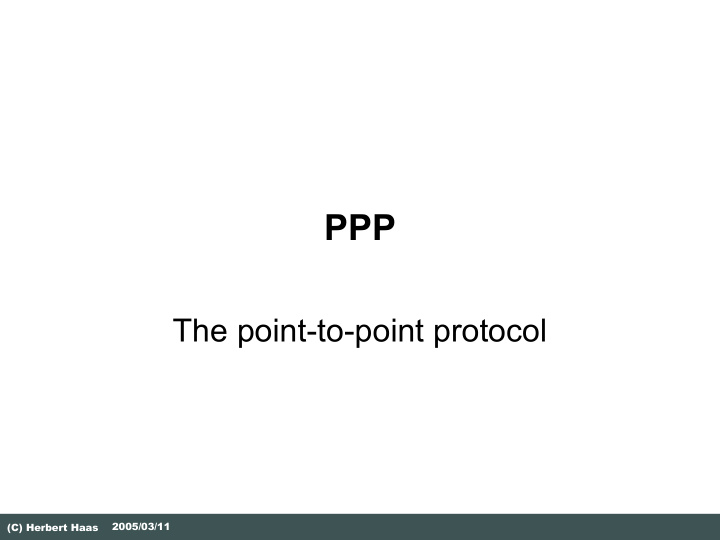



PPP The point-to-point protocol 2005/03/11 (C) Herbert Haas
PPP versus SLIP PPP Where is PPP used What is the task of LCP What is the task of NCP SLIP Serial Line IP Predecessor of PPP We don't even think of it today 2005/03/11 (C) Herbert Haas 2
Introduction (1) Goal of PPP Convey datagrams over a serial link Both synchronous or asynchronous serial links are supported Both bit or byte oriented transmissions are supported Basically, PPP consists of One Link Control Protocol (LCP) Several Network Control Protocols (NCPs) 2005/03/11 (C) Herbert Haas 3
Introduction (2) HDLC is basis for encapsulation Only framing and error detection necessary Only simple unnumbered information frames (UI) PPP supports full-duplex links only (!) PPP Frame = Datagram + 2-8 bytes extra header Extra header consists of HDLC header and PPP header Byte Stuffing: Data dependent overhead! 2005/03/11 (C) Herbert Haas 4
LCP Link Control Protocol (LCP) Setup, configure, test and terminate PPP connection Supports various environments LCP negotiates Encapsulation format options Maximal packet sizes Identification and authentification of peers (!) Determination of proper link functionality 2005/03/11 (C) Herbert Haas 5
NCPs Network Control Protocols (NCPs) Helper to establish various network protocols IP uses "IPCP" Typical tasks Assignment and management of IP addresses Compression and authentication 2005/03/11 (C) Herbert Haas 6
Data Link Layer: HDLC Address 11111111 means "all stations" PPP does not assign individual station addresses Only the control field 00000011 is used Unnumbered Information (UI) command Protocol field identifies datagram Already part of PPP, not HDLC (!) Flag Flag Address Address Control Control Protocol Protocol Data Data FCS FCS Flag Flag 01111110 11111111 00000011 16 Bits .... 16 Bit CRC 01111110 (126) (255) (003) (126) Up to 1500 bytes data 2005/03/11 (C) Herbert Haas 7
Protocol Field 0xxx – 3xxx L3 protocol type 4xxx – 7xxx L3 protocol type without associated NCPs 8xxx – bxxx Associated NCPs for protocols in range 0xxx – 3xxx cxxx – fxxx LCP, PAP, CHAP, ... 0021 IP Important Examples 002b Novell IPX 002d Van Jacobson Compressed TCP/IP c021 Link Control Protocol (LCP) 002f Van Jacobson Uncompressed TCP/IP c023 Password Auth. Protocol (PAP) c025 Link Quality Report 8021 IP-NCP (IPCP) c223 Challenge Handshake Auth. Protocol (CHAP) 802b IPX-NCP (IPXCP) 2005/03/11 (C) Herbert Haas 8
CHAP – The Challenge Handshake Authentication Protocol Supports 1-way and 2-way authentication Periodically verifies the identity of the remote node using a three-way handshake Relies on MD5 hash (regarded as weak today) Offline dictionary attacks possible! Still widely used Request to login, User="LEFT", Challenge_1 User="RIGHT", MD5_hash(Challenge_1, KEY), Challenge_2 MD5_hash(Challenge_2, KEY) 2005/03/11 (C) Herbert Haas 9
PPP today Is still a usual choice when carrying IP packets over high-speed serial lines Several flavors for different media PPPOE (over Ethernet) PPPOA (over ATM) PPTP (Tunnel PPP through a IP network) POS – Packet over SONET/SDH See RFC 1661, 1662 2005/03/11 (C) Herbert Haas 10
Recommend
More recommend